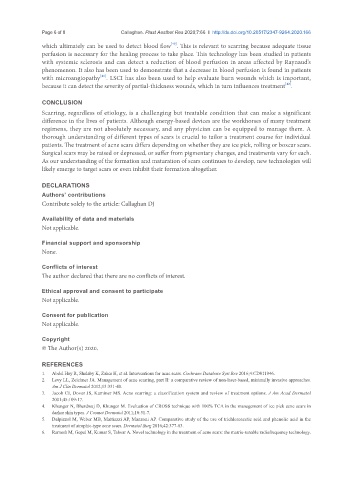Page 784 - Read Online
P. 784
Page 6 of 8 Callaghan. Plast Aesthet Res 2020;7:66 I http://dx.doi.org/10.20517/2347-9264.2020.166
[40]
which ultimately can be used to detect blood flow . This is relevant to scarring because adequate tissue
perfusion is necessary for the healing process to take place. This technology has been studied in patients
with systemic sclerosis and can detect a reduction of blood perfusion in areas affected by Raynaud’s
phenomenon. It also has been used to demonstrate that a decrease in blood perfusion is found in patients
[41]
with microangiopathy . LSCI has also been used to help evaluate burn wounds which is important,
because it can detect the severity of partial-thickness wounds, which in turn influences treatment .
[42]
CONCLUSION
Scarring, regardless of etiology, is a challenging but treatable condition that can make a significant
difference in the lives of patients. Although energy-based devices are the workhorses of many treatment
regimens, they are not absolutely necessary, and any physician can be equipped to manage them. A
thorough understanding of different types of scars is crucial to tailor a treatment course for individual
patients. The treatment of acne scars differs depending on whether they are ice pick, rolling or boxcar scars.
Surgical scars may be raised or depressed, or suffer from pigmentary changes, and treatments vary for each.
As our understanding of the formation and maturation of scars continues to develop, new technologies will
likely emerge to target scars or even inhibit their formation altogether.
DECLARATIONS
Authors’ contributions
Contribute solely to the article: Callaghan DJ
Availability of data and materials
Not applicable.
Financial support and sponsorship
None.
Conflicts of interest
The author declared that there are no conflicts of interest.
Ethical approval and consent to participate
Not applicable.
Consent for publication
Not applicable.
Copyright
© The Author(s) 2020.
REFERENCES
1. Abdel Hay R, Shalaby K, Zaher H, et al. Interventions for acne scars. Cochrane Database Syst Rev 2016;4:CD011946.
2. Levy LL, Zeichner JA. Management of acne scarring, part II: a comparative review of non-laser-based, minimally invasive approaches.
Am J Clin Dermatol 2012;13:331-40.
3. Jacob CI, Dover JS, Kaminer MS. Acne scarring: a classification system and review of treatment options. J Am Acad Dermatol
2001;45:109-17.
4. Khunger N, Bhardwaj D, Khunger M. Evaluation of CROSS technique with 100% TCA in the management of ice pick acne scars in
darker skin types. J Cosmet Dermatol 2011;10:51-7.
5. Dalpizzol M, Weber MB, Mattiazzi AP, Manzoni AP. Comparative study of the use of trichloroacetic acid and phenolic acid in the
treatment of atrophic-type acne scars. Dermatol Surg 2016;42:377-83.
6. Ramesh M, Gopal M, Kumar S, Talwar A. Novel technology in the treatment of acne scars: the matrix-tunable radiofrequency technology.

